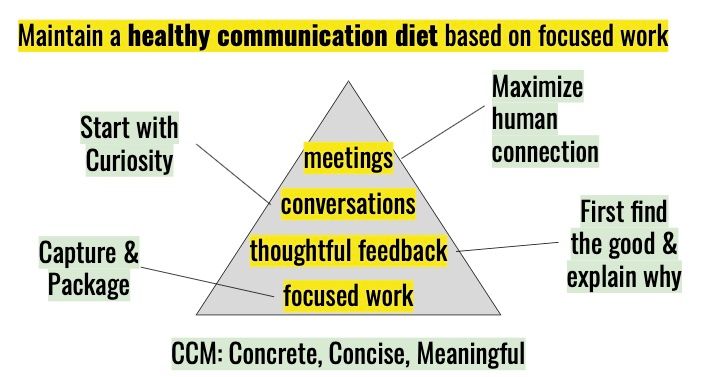🕯️ Organize your communication around focused work

Where does teamwork happen?
For many teams it’s in meetings.
Sure, everyone might have tasks to work through on their own, but in many teams the key interactions happen in meetings and conversations.
There’s nothing wrong with that IF it works well for your team.
But it doesn’t always.
A strong everything-is-a-meeting habit may lead to:
- people wasting time,
- people being nailed to their workstations without much flexibility to adjust their schedule,
- frequent unpleasant surprises, when a lot of what’s discussed is quickly forgotten.
On top of that remote work is a whole new medium.
Remote work is fundamentally different than office work and we should take advantage of that.
One important idea in this new world is async.
Enabling asynchronous work is a big opportunity to improve the way your team communicates and collaborates.
Being able to work more asynchronously can improve:
- depth of focus which leads to higher quality thinking,
- flexibility to work whenever is best for you,
- durability of work-products including supporting artifacts like working notes, outlines and sketches.
The main challenge of async is keeping individual work well connected. To make our work available for others to use. To enable everyone to meaningfully help each other. To ultimately tie it all to our common goal.
Async is not about a meeting prohibition. We still want to be able to talk to each other in smaller and yes, sometimes bigger groups. The main idea is to keep the right balance.
Inspired by the Nozbe communication pyramid here’s a simple model that can help you figure out the right balance for your team:

1) The foundation of this pyramid is individual focused work.
2) When we’re done with a focused work session we should be able to capture and package the results of that work. It could a shared document, a comment on an internal blog or your favorite ticketing system. The main goal is to allow others to give thoughtful feedback and also to use your work in their own efforts.
3) When we want to go back and forth quickly we can have conversations in chat or voice.
4) And when we need to connect more people at the same time we run a meeting. But since we’ve focused on the other layers of the pyramid first those are fewer and more deliberately optimized for a specific purpose.
That is the pyramid of healthy communication based on focused work.
And how is it for you?
What kinds of communication dominate on your team? How well is that balance working for you?
See you soon, Michał